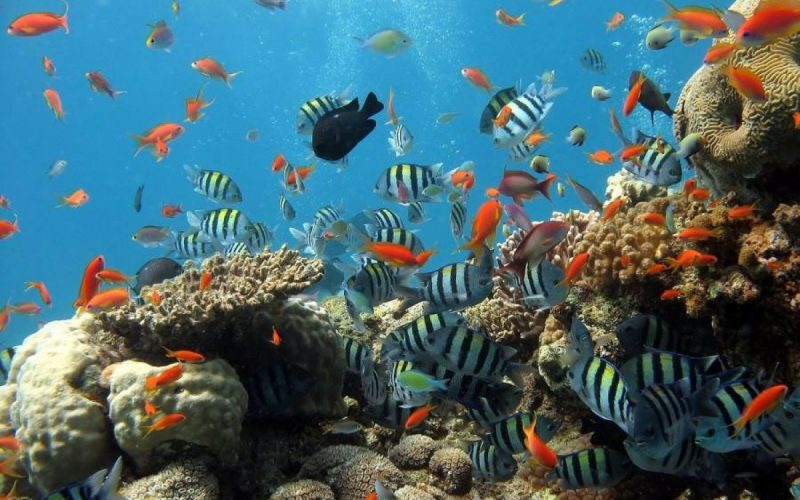Saltwater aquariums, also known as marine aquariums or reef tanks, offer a captivating glimpse into the vibrant underwater world, showcasing the mesmerizing beauty and intricate ecosystems of coral reefs. These captivating creations bring a touch of the ocean’s splendor into our homes, allowing us to observe the diverse array of marine life that thrives in these underwater kingdoms.
While the allure of saltwater aquariums is undeniable, establishing and maintaining a thriving marine ecosystem requires careful planning, dedication, and a deep understanding of the delicate balance that exists within these underwater habitats. This comprehensive guide delves into the intricacies of saltwater aquariums, equipping you with the knowledge and strategies to create and nurture a flourishing underwater oasis in your own home.
Unveiling the enchanting world of saltwater aquariums
Saltwater aquariums, unlike their freshwater counterparts, replicate the environmental conditions of coral reefs, the vibrant underwater cities teeming with life. These reefs, found in tropical and subtropical regions, are home to an astonishing diversity of organisms, including colorful fish, corals, invertebrates, and algae.
The allure of saltwater aquariums lies in their ability to transport us into this underwater realm, allowing us to observe the intricate interactions between these marine creatures and witness the mesmerizing beauty of coral formations. Saltwater aquariums not only serve as captivating visual displays but also provide opportunities to learn about the delicate balance of marine ecosystems and the importance of conservation efforts.
Establishing your saltwater aquarium: a journey into preparation
Before embarking on the journey of creating your saltwater aquarium, it is crucial to carefully consider the planning and preparation phases. These steps will lay the foundation for a successful and thriving marine ecosystem.
- Selecting the right tank: The size of your saltwater aquarium will depend on the available space in your home and the types of marine life you wish to keep. Larger tanks offer more stability and provide ample space for a diverse array of organisms, while smaller tanks may be suitable for beginner hobbyists or those with limited space.
- Choosing the location: Place your saltwater aquarium in a stable, level location away from direct sunlight and drafts. Ensure the area has adequate ventilation and easy access for maintenance tasks.
- Selecting appropriate equipment: The essential equipment for your saltwater aquarium includes a filtration system, lighting system, protein skimmer, heater, and thermometer. Research and select equipment that is appropriately sized for your tank and compatible with the marine life you intend to keep.
- Establishing the substrate: The substrate, or bottom layer of your aquarium, provides a foundation for corals and other organisms. Popular substrate choices include live sand, crushed coral, and aragonite.
- Creating the rockwork: Rockwork serves as a structural base for corals and provides hiding places for fish. Arrange the rocks in a stable and aesthetically pleasing manner, leaving ample open spaces for water flow.
- Preparing the water: Saltwater aquariums require saltwater that closely mimics the salinity of natural seawater. Use high-quality marine salt and carefully mix it with reverse osmosis or distilled water to achieve the desired salinity level.
- Cycling the aquarium: Cycling the aquarium is a crucial step that allows beneficial bacteria to establish themselves in the filtration system, breaking down harmful ammonia and nitrite. This process typically takes several weeks and requires patience and careful monitoring of water parameters.

Introducing marine life: a delicate balance
Once your saltwater aquarium has cycled and the water parameters are stable, you are ready to introduce marine life. Begin by adding hardy, low-maintenance fish and invertebrates, gradually introducing more sensitive species as the ecosystem matures.
- Quarantining new arrivals: To prevent the introduction of diseases or parasites into your aquarium, quarantine all new marine life in a separate tank for several weeks before adding them to the main display.
- Acclimating to the aquarium: Before releasing new marine life into the aquarium, slowly acclimate them to the water parameters by gradually equalizing the temperature and salinity levels between the quarantine tank and the main display.
- Compatibility considerations: Carefully research the compatibility of different marine species to avoid aggression, competition for resources, or predation. Choose species with similar temperaments and environmental requirements.
- Feeding your marine life: Provide your marine life with a varied diet that meets their specific nutritional needs. Offer a combination of high-quality flake food, pellets, frozen foods, and live algae or plankton.
Conclusion
Creating and maintaining a thriving saltwater aquarium is a rewarding yet challenging endeavor. It requires dedication, knowledge, and a commitment to providing a healthy and stable environment for your marine life. By following these guidelines, you can establish a mesmerizing underwater oasis in your home, allowing you to witness the beauty and complexity of marine ecosystems firsthand. Remember, patience, consistent care, and a respect for the delicate balance of these underwater worlds are key to ensuring the long-term success of your saltwater aquarium. As you delve deeper into this captivating world, you’ll gain a newfound appreciation for the wonders of the ocean and the importance of preserving these precious marine environments.
Visit: Heat water resistance.

